What is acceleration?
How an object changes velocity.
What is an example of a directly proportional relationship in your life?
An example of a directly proportional relationship is the cost to purchase multiple identical items at a grocery store. If I were to purchase 4 cans of identical soda, the cost would be exactly twice as high as purchasing 2 cans of the same soda. If the amount of soda cans doubles, the overall cost to me will double; if the amount of soda cans triples, the overall cost to me will triple; and so on.
Using the graph below, which object was pushed by a greater force (both have the same mass)? How do you know?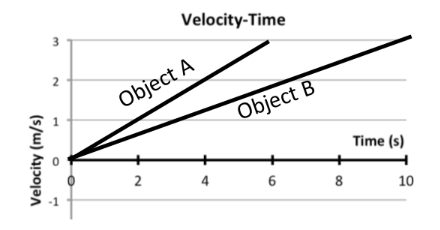
If both objects have the same mass, then Object A was pushed by a greater force. When we changed the strength of the fan force pushing two identical carts, the cart with the strongest fan force increased its velocity at a greater rate (had a greater acceleration). Its velocity-time graph had a steeper slope than the cart being pushed by the weaker fan. In the velocity-time graph shown, Object A has the steeper line, so it is being pushed by a greater force than Object B.
What does the term slope mean?
Describes how steep a line is, or how much y (velocity) changes as x(time) increases.
What symbol is used for directly proportional relationship?

If the force is held constant, doubling the mass will cause the acceleration to...
Halve.
What is an example of an inversely proportional relationship in your life?
I feel more tired during the day if I sleep less the night before, and vice versa. Another example is the time it will take to reach a destination in a car, which decreases as the car’s velocity increases. The faster I go, the less time it will take to arrive.
Which time frames show a force acting on an object? 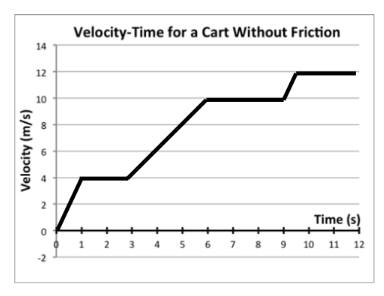
0 seconds to 1 second
3 seconds to 6 seconds
9 seconds to approximately 9.5 seconds.
What is inertia?
Resistance to change
What is the equation for Newton's second law?

If the force is held constant, halving the mass will cause the acceleration to...
Double.
True or false: The greater the mass, the smaller the acceleration
TRUE, they have an inversely proportional relationship
Describe how you can tell if a force is acting on an object by looking at the velocity-time graph.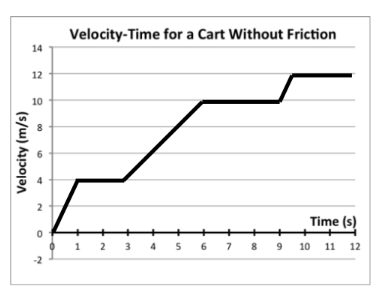
We can infer that a force is acting on an object whenever the velocity-time graph for that object shows that the object’s velocity is changing.
What does directly proportional relationship mean?
As one increases, the other increases. As one decreases, the other decreases.
Is this a directly proportional relationship or an inversely proportional relationship?
I feel more tired during the day if I sleep less the night before, and vice versa.
Inversely proportional relationship
True or false: The greater the force, the greater the acceleration
True
What evidence did you collect that supports the idea that mass and acceleration are inversely proportional?
When we had two identical fan forces pushing on carts of different mass, we observed that the heavier cart changed its velocity at a smaller rate (had a smaller acceleration) than the lighter cart. This was true for speeding up and slowing down. Since the cart’s acceleration increased as its mass decreased and vice versa, we can infer that mass and acceleration are inversely proportional.
Describe how you are able to tell if no forces are acting on an object by looking at the velocity-time graph.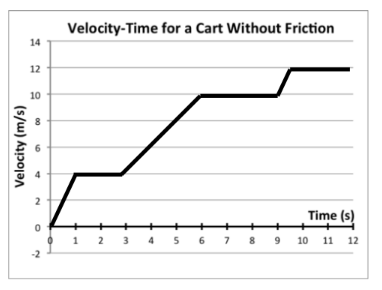
If the velocity-time graph is showing constant speed (a horizontal line), we can infer that no forces are acting on the object.
What does an inversely proportional relationship mean?
As one increases, the other decreases (vice versa)
Is this a directly proportional relationship or an inversely proportional relationship?
If I were to purchase 4 cans of identical soda, the cost would be exactly twice as high as purchasing 2 cans of the same soda. If the amount of soda cans doubles, the overall cost to me will double; if the amount of soda cans triples, the overall cost to me will triple; and so on.
Directly proportional relationship
What does the slope on a velocity-time graph tell us about acceleration?
Acceleration is a measure of how much an object’s velocity changes over time, and this is exactly what the slope of a velocity-time graph expresses. The slope tells us how much the y-variable (velocity) is changing in relation to the x-variable (time).
What evidence did you collect that supports the idea that force and acceleration are directly proportional?
When we changed the strength of the fan force pushing two identical carts, the cart with the strongest fan force increased its velocity at a greater rate (had a greater acceleration). Its velocity-time graph had a steeper slope than the cart being pushed by the weaker fan. This was true for speeding up and for slowing down. Since we observed that the acceleration increased/decreased as the applied force increased/decreased in strength, we can infer that these quantities have a directly proportional relationship.
Describe how you are able to tell if a force is acting on an object by looking at the force-time graph.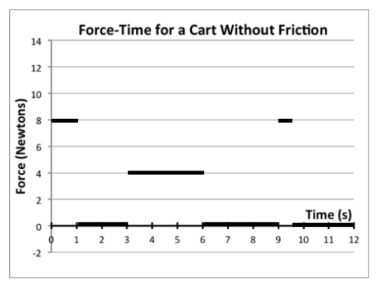
A force is only acting in the time intervals from 0 seconds to 1 seconds, from 3 seconds to 6 seconds, and from 9 seconds to approximately 9.5 seconds.
Summarize Newton’s Second Law in your own words.
Newton’s Second Law states that the force applied on an object has a directly proportional relationship to the acceleration the object will obtain, as in, if I push with greater strength, the object’s velocity will change at a greater rate. It also states that the acceleration an object will obtain as a result of an applied force is inversely proportional to the object’s mass – as in, it is more difficult to change the velocity of an object that is heavier, when all else is equal.
Why is it harder to stop a semi-truck than it is to stop a small car if they are both traveling at the same speed?
It is harder to stop a semi-truck than a small car because the semi-truck has a larger mass. If we assume that both vehicles have brakes that are able to apply the same strength force to their tires, the semi-truck’s acceleration will be smaller because it is much heavier. According to Newton’s Second Law, the acceleration that an object will obtain as a result of an applied force has an inversely proportional relationship to its mass.